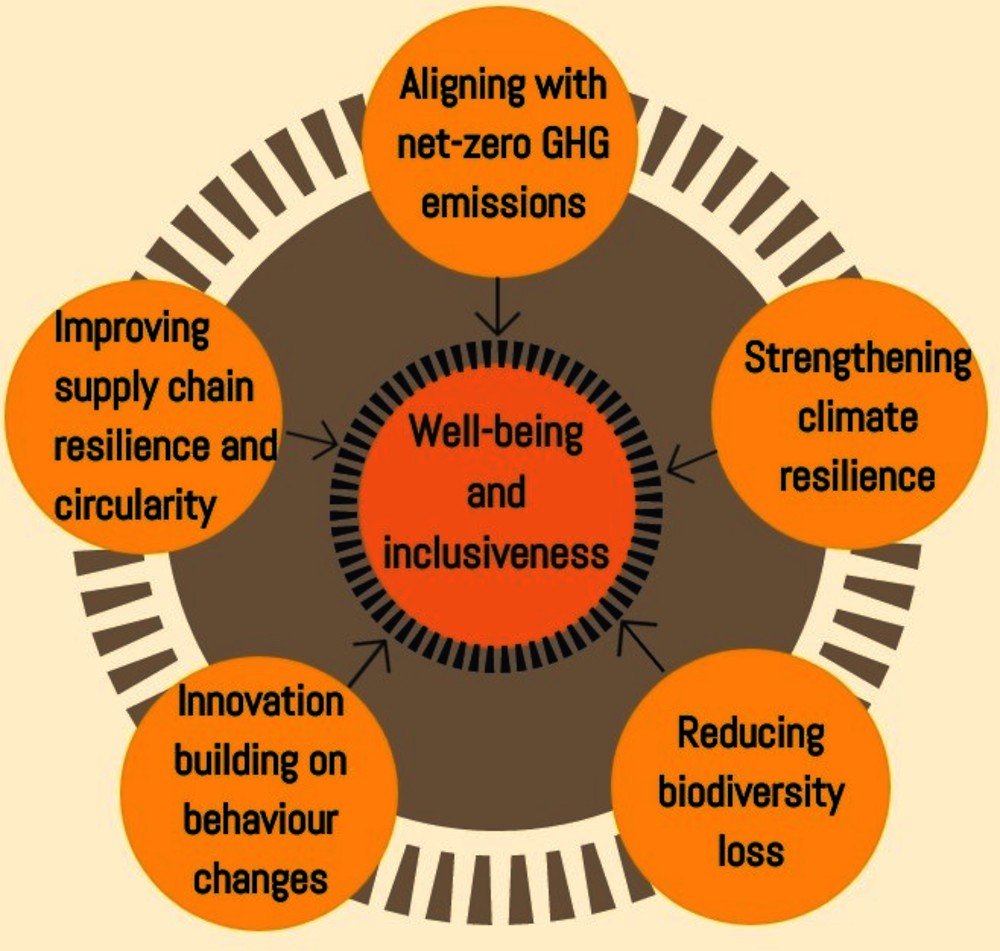- Blog
- Building Back Better: A Sustainable, Resilient Recovery After COVID-19
Building Back Better: A Sustainable, Resilient Recovery After COVID-19
Abstract
For economic recovery after the COVID-19 crisis to be strong and long-lasting, we should not return to “business as usual.” That includes avoiding investment habits and activities that harm the environment. If left unchecked, global problems like climate change and biodiversity loss could lead to social and economic damage far worse than the impact of COVID-19.
To prevent this outcome, recovery efforts must be centered on “building back better.” This goes beyond simply restarting economies and helping people regain their jobs or incomes. Effective recovery policies should lead to new investment choices and changes in behavior that lower the risk of future disruptions. These changes can also make societies more prepared and able to recover when problems do occur.
A major part of this approach is prioritizing people’s well-being and equal opportunities. It’s also important to consider how recovery plans align with long-term goals to cut emissions, how well they prepare for the effects of climate change, how they help slow the loss of nature, and how they promote more sustainable supply chains.
In practice, a well-planned recovery strategy can meet several of these goals simultaneously. For example, it can encourage the shift to transportation systems based on access rather than ownership and promote clean, low-carbon, locally managed energy networks.
Governments’ first steps in dealing with the COVID-19 crisis focused on handling the public health emergency and quickly rolling out economic support. These emergency measures mainly aimed to keep money flowing and protect jobs as many people suddenly lost their income. Now that the health situation is easing in some countries, the focus is shifting to planning stimulus efforts that can help economies recover.
This policy brief looks at how recovery plans can go beyond short-term fixes and help “build back better.” That means doing more than just restarting economies and jobs. It’s also about making sure long-term prosperity is protected. To do this, governments need to encourage investments and changes in society that will lower the chances of future crises – and help us better deal with them when they happen, whether they’re caused by new diseases or damage to the environment.
The key to this approach is moving toward societies that are more inclusive, better prepared, and based on low or zero greenhouse gas emissions, with far less harm to the natural world. Other OECD policy briefs explore related areas, including how protecting environmental health can make us more resilient to future pandemics and how COVID-19 links with the transition to a low-carbon economy.
A More Resilient Economy Depends on a Shift to Sustainable Practices
Alongside the direct impact of COVID-19 on public health and the widespread loss of jobs and income, the pandemic has exposed serious weaknesses in our global systems. For decades, global connectivity brought major economic and social progress, though unevenly. But it also made the fast spread of the virus possible. The sudden and deep economic crisis has revealed the downside of prioritizing short-term economic growth and efficiency over long-term strength and stability. Many countries found themselves unable to secure medical supplies and other essentials due to how fragile and complicated global supply chains have become. At the same time, the rapid loss of jobs has made existing inequalities even worse, with more than 300 million jobs at risk globally. While past economic downturns have shown some of these same problems, the scale of the current crisis has pushed the need for resilience and preparation into the spotlight.
These weaknesses are especially concerning when considering the even larger challenge ahead: environmental damage caused by how our economies operate. The planet’s environmental threats haven't gone away, even during this very human-centered crisis. Problems like climate change, air, and water pollution, the loss of nature, and declining ocean health are already causing serious harm and exposing new risks for the global economy – risks that could be even more severe than COVID-19. We are already seeing the effects of climate change, and some areas have faced severe weather events while also dealing with the pandemic, such as super-cyclone Amphan in Bangladesh and Typhoon Vongfong in the Philippines. If we don’t make real changes to how our economies function, the continued rise of greenhouse gases (GHGs) will bring even more dangerous consequences. Although lockdowns led to temporary improvements – like fewer emissions and cleaner water – these gains are not enough on their own. If we return to previous economic patterns, these short-term environmental benefits will disappear. In fact, after past crises, emissions quickly went back up.
Environmental problems are also tied to the risk of future disease outbreaks. As economic pressures continue to damage ecosystems and oceans, the chances of new diseases spreading may increase. This includes diseases passed from animals to humans, known as zoonotic viruses. Deforestation and wildlife trade are major contributors to this risk. At the same time, pollution in the air and water lowers communities' ability to handle disease and climate change, and poorer areas tend to be hit harder.
Going back to how things were before will not lead to a strong, long-term recovery that also improves lives and reduces inequality. With governments around the world planning major spending to help their economies, there’s now a key moment to think beyond short-term fixes. We need to reflect on the deeper causes – both political and economic – that contributed to this crisis.
Some progress is being made, but current recovery plans are still falling short. Many leaders have acknowledged the chance for a greener, fairer recovery. For instance, in April 2020, G20 Finance Ministers agreed to “commit to supporting an environmentally sustainable and inclusive recovery”. A global survey of people in both wealthy and developing countries also found that most still see environmental issues as a major concern, even during the pandemic. The weaknesses revealed by COVID-19 may help highlight why environmental action had become such a key issue even before the crisis. In 2019, millions – led by young people – took to the streets demanding climate action, leading some governments to declare a “climate emergency.” At the same time, the decline in wildlife and mass species loss was gaining global attention. The crisis facing oceans was becoming a major political issue in several countries. As recently as January 2020, the World Economic Forum listed climate change and biodiversity loss as top global risks. There is strong evidence for a recovery that is both sustainable and resilient. Yet, many current recovery plans don’t meet that goal. In fact, in several countries, more funding is going to environmentally harmful activities than to sustainable solutions. While support for green technologies and industries is growing – especially in Europe – it is still often outweighed by continued investment in polluting industries, which risks locking in high-emission pathways.
“Building Back Better”: Key Dimensions for a Resilient Economic Recovery
The phrase “Building Back Better” has become widely used during the economic recovery from the COVID-19 crisis. This idea originally came from disaster recovery work, where the goal was to invest in ways that make systems stronger and more prepared for future physical disasters. While the COVID-19 crisis wasn’t a natural disaster, and it has affected the whole world, the scale of its economic damage, the risks of returning to old ways, and the clear opportunity for a greener recovery make the phrase just as relevant now. Even globally, the focus on prevention remains important. The choices we make now – both in terms of investment and behavior – can reduce future risks and make us better prepared for major disruptions like climate change, health emergencies, or a mix of challenges.
To truly “build back better,” recovery actions should be judged using several important criteria. One thing they all have in common is the need to think long-term, even while taking quick action. For instance, comparing different uses of stimulus funds may reveal that while two projects create similar short-term job gains, their long-term effects could be very different. A plan that funds projects producing high emissions over decades can set back environmental goals, while alternatives may support cleaner, more sustainable outcomes that make economies stronger and more resilient in the future.
A central dimension of building back better is the need for a people-centered recovery that focuses on well-being, improves inclusiveness, and reduces inequality.
A recovery that prioritizes people must aim to improve well-being, reduce inequality, and make societies more inclusive. Success cannot be measured solely by economic growth or job numbers. Recovery policies should also be judged by how they improve people’s daily lives – this includes income levels, job quality, access to housing, and health services.
This is especially true when stimulus funds are used for environmental goals. If these green policies are going to gain long-term support, they need to be seen as improving lives. Even before COVID-19, the effect of environmental policies on inequality – across and within countries and between genders – was already a growing concern. That concern is even more pressing now.
Governments can take specific steps to ensure that green recovery plans are fair and inclusive. These include making taxes and subsidies progressive to protect the most vulnerable and helping workers adjust to a green economy. This could mean applying “Just Transition” strategies in ways that reflect today's economic challenges and recovery needs.
The relative importance of the other dimensions will likely vary across different country contexts, according to their development priorities, infrastructure needs, and social circumstances, in particular for developing countries. These dimensions include:
- Aligning recovery measures with long-term objectives for reducing GHG emissions.
Avoiding the worst effects of climate change is essential for long-term resilience. Governments must carefully examine how their stimulus spending impacts future emissions. This includes short-term emissions from activities receiving support and long-term consequences from investments in infrastructure. Because infrastructure decisions last for decades, what gets funded now could shape the global path toward – or away from – net-zero emissions. - Strengthening resilience to the impacts of climate change.
Climate resilience is critical to building stronger economies and communities. Infrastructure will face growing pressure from climate impacts, but it also plays a key role in helping society respond to those impacts. Many recovery plans include infrastructure projects due to their potential to create jobs. It’s vital that these projects are climate-resilient and don’t increase future risk. Making new infrastructure climate-ready now helps avoid damage and disruption later. Retrofitting it later will be more costly and complicated. - Integrating more ambitious policies to halt and reverse biodiversity loss and restore ecosystem services, including through nature-based solutions.
Nature and ecosystems are essential to economies and public health. Land use changes – like deforestation – have been tied to disease outbreaks. Investments in natural systems, such as restoring forests, wetlands, or mangroves, are cost-effective and support climate resilience. These projects also create jobs, just like traditional infrastructure. Stimulus measures should reflect the value of biodiversity in their decisions. Support that harms biodiversity should be reformed. Better environmental health – like clean air and water – also helps societies cope with pandemics and shocks. - Fostering innovation that builds on enduring behavior changes.
Continued innovation will be vital for reaching sustainability and climate targets. Governments must support not just research, but the full ecosystem that enables new ideas to grow. COVID-19 has already changed social behavior in ways we’re still figuring out. To be effective, stimulus plans must account for those shifts. For example, if people are less willing to use crowded public transit, investments may need to focus on safer, cleaner alternatives. Supporting remote work can also reduce the demand for transport while improving well-being. - Improving the resilience of supply chains, including through increased adherence to circular economy principles.
The pandemic and related lockdowns have revealed weaknesses in global supply chains. These disruptions have led to new interest in more local, flexible production. While the environmental impact of this shift isn't yet clear, policy can help ensure it's positive. Recovery plans should encourage resource efficiency and circular economy practices to reduce waste, improve sustainability, and make supply chains more shock-resistant.

Fortunately, designing stimulus measures in this way does not mean starting with a blank slate. There are already global agreements and frameworks that support these goals. These include the Paris Agreement, the Aichi Biodiversity Targets, and the Sendai Framework for disaster risk reduction. The UN Sustainable Development Goals also offer guidance for connecting social progress and environmental protection.
Policy tools to support a better recovery already exist. While GHG emissions were rising before the pandemic, decades of experience in designing climate policies can still guide today’s decisions. There is also strong policy knowledge in areas like biodiversity protection and circular economy planning. Lessons learned from the 2008–2009 financial crisis also show how environmental measures can be part of stimulus plans.
“Building Back Better” in Practice
This part shares examples of how “building back better” can work across different sectors. It points out where government stimulus funds can be directed to support multiple goals at once. These examples aren’t a full list, but they are chosen because they show where public investment can push important changes in the economy and also help meet the urgent need for job creation. In some cases, these efforts can also lead to long-term improvements in resilience.
Improving Biodiversity While Keeping Food Supplies Secure
Natural areas like forests, wetlands, and mangroves are key to many industries and support the livelihoods of millions. These ecosystems also help communities bounce back from shocks. However, this natural value is often overlooked, and nature is mostly seen as something to be used or harvested rather than valued for the services it provides. In 2013, the unpriced use of natural resources by sectors like farming, forestry, fishing, mining, and some raw material industries (such as cement and steel) was estimated at USD 7.3 trillion. While there have been some efforts to recognize the value of nature – such as payments for ecosystem services – current tools for tracking and valuing losses in natural capital are still limited. Recovery spending gives governments a chance to attract more private money into nature-based solutions and push companies and investors to track their impact on biodiversity. For example, financial support for agriculture and other nature-related sectors could come with requirements to assess biodiversity risks, dependencies, and opportunities.
What Policy Can Do
Although “building back better” involves many specific policy areas, there are several core recommendations governments should take into account:
- Evaluate all parts of stimulus packages for their long-term impact across the key areas mentioned earlier, and prioritize measures that:
- Create jobs reduce inequality while supporting long-term resilience, and avoid locking in high-emission systems or infrastructure.
- Can be rolled out quickly, including “shovel-ready” public investments and scaling up existing policies.
- Encourage cross-sector and cross-government collaboration, with a focus on systemic and long-term outcomes rather than single technologies.
- Coordinating across ministries will help develop a strong pipeline of “shovel-ready” sustainable infrastructure projects. This includes identifying projects that can be deployed quickly without defaulting to emission-heavy activities just because they’re easy to launch.
- Keep long-term environmental goals, such as net-zero emissions, a top priority, and make sure stimulus-driven policies and investments support those targets. For example:
- Don’t weaken environmental rules just to ease short-term pressures since the long-term costs of doing so are likely to be greater.
- Subsidies and financial support for industries should be conditional on improvements in environmental outcomes (such as reduced GHG emissions) and workforce resilience.
- Align energy pricing with climate and social goals during fiscal recovery – this includes phasing out fossil fuel subsidies and introducing carbon pricing that supports households and workers (e.g., using revenue to offset costs or fund job transition programs).
- Boost green finance to build long-term resilience and support financial decisions with a future-focused lens by:
- Measuring whether investment flows are aligned with climate mitigation and resilience goals using existing public and private sector initiatives.
- Promoting clear and transparent definitions for green finance (e.g., through classification systems) to help guide investment.
- Enhancing the role of public finance institutions by expanding their lending power and co-investment abilities to attract private capital.
- Strengthen the ability to evaluate and disclose climate-related financial risks using existing tools and frameworks (such as TCFD and NGFS) to support public reporting and risk management.
- Shape public procurement policies to reward resilience, low carbon outcomes, and innovation – for example, by:
- Ranking bids based on total lifetime costs under different climate scenarios.
- Considering full life-cycle greenhouse gas emissions in procurement decisions.
- Provide targeted reskilling and training programs for sectors affected by both the immediate crisis and long-term decarbonization. This should go hand-in-hand with policies like housing reform that support workforce mobility.
The food industry plays a crucial role in protecting and using natural resources sustainably. At the same time, it heavily depends on these resources. Having a stable food supply is key to people’s well-being and a steady economy – and simply vital for survival. Because of this, making sure food is affordable and accessible will likely remain a top priority for governments as they move forward after the crisis.
Agriculture is under increasing pressure from risks like climate change and disease outbreaks among plants and animals. It’s also one of the main contributors to environmental damage. Converting land for farming is a major cause of deforestation. On top of that, using too much fertilizer harms freshwater and marine environments due to runoff. The environmental stress linked to agriculture may also increase the risk of new human diseases. Farming near untouched nature can hurt biodiversity, while more intensive farming, such as having more animals in smaller spaces, raises the risk of diseases jumping from animals to humans.
Agriculture already gets significant public funding worldwide. In 2019, farmers in 53 countries received around USD 528 million in support. While recovery funds can help protect jobs and food supplies, they should also support changes that improve environmental outcomes, strengthen resilience, and promote innovation for better yields. In light of the COVID-19 crisis, there’s an opportunity to review and reduce the most harmful subsidies, such as those tied to output or livestock numbers or those that ease environmental rules. Without reform, such policies could prolong unsustainable farming methods and slow the shift to more sustainable food systems. Support for training and investments that help farmers switch to eco-friendly methods can benefit the environment, climate, and their livelihoods.
In general, what people choose to eat can have a big impact on the climate and their own health. Where people already get enough protein, promoting foods with a lower environmental footprint – like more plant-based meals or livestock raised with fewer emissions – can help. Public campaigns and education are good ways to encourage this. At the same time, it’s important that governments make sure low-income communities have enough healthy food. Food vouchers or extra subsidies might help, but these efforts must also make sure people can physically access nutritious options.
Investing in Low-carbon, Resilient Electricity Systems
Economic recovery efforts can speed up the move to a low-carbon, climate-resilient electricity system and create jobs. Large renewable energy projects are still important, but smaller local energy systems, improved energy efficiency, and more flexible power grids also offer major benefits.
Energy-related recovery plans must account for changes in the global energy landscape. In 2020, demand for energy dropped significantly, causing oil and gas prices to fall and become unstable. These low prices reduce the motivation to invest in efficiency and renewables. Energy investments are expected to shrink sharply this year – even in clean energy. That’s why it’s critical to use stimulus funds to back large renewable projects like wind and solar, which are ready to go. But these are just part of the picture. Recovery plans should also boost investment in energy-saving efforts and in systems that can handle both climate risks and sudden drops in demand, like those seen during the pandemic. In developing nations, expanding access to power – including off-grid and mini-grid renewable setups – can help with job creation, health, and resilience.
Energy efficiency is a strong fit for a green recovery. It’s crucial for climate targets and usually creates many jobs. In the US and EU alone, more than 3.3 million people work in this sector, mostly in small or mid-sized businesses. Focusing on saving energy and boosting local energy systems also helps make power grids more reliable, keeps costs down, and reduces environmental damage. The building sector, discussed later, is a key area for efficiency gains. Using electricity instead of fossil fuels – like electric vehicles, heat pumps, or clean industrial equipment – can cut pollution. But how much this helps the climate depends on how green the electricity is and whether the system can handle more demand.
Expanding energy-saving programs and small-scale clean energy projects after the crisis may be tough due to their size and because homes and businesses may lack money to invest. Governments can build on current programs, set up lists of ready-to-go projects, and work with partners like utilities or city governments. They can also use tools like on-bill financing to scale up efforts without creating a short-lived boom. Job training is also key – especially for roles like energy system engineers and building retrofit experts.
Another smart use of stimulus money is to invest in making electricity systems more flexible. This could involve adding storage like lithium-ion batteries, rolling out smart meters, or improving how grids are connected. These tools are important for using more renewables and adjusting to shifts in power use. The lockdowns during COVID-19 showed how valuable grid flexibility is – lower demand increased the share of renewables since they cost less to operate. Finally, new technology will be essential for achieving net-zero goals in the long term. That includes innovations like carbon capture and storage.
Energy-Efficient Housing as Part of Compact, Resilient, and Sustainable Cities
The COVID-19 lockdowns, which kept millions confined to their homes, exposed serious problems in housing and revealed deep inequalities. Poor-quality housing and lack of basic services like sanitation have made it clear how living conditions impact health and safety. Inadequate homes also bring higher energy bills because of poor energy efficiency and can lead to issues like indoor air pollution, adding to health risks.
Cities – and the buildings in them – play a major role in improving energy efficiency. Buildings contribute nearly 30% of global CO₂ emissions, both from burning fuels for heat and from electricity use. To meet the Paris Agreement targets, both old buildings need retrofitting, and new buildings must meet high energy standards. Still, many barriers stand in the way: high upfront costs, lack of incentives for landlords and tenants, and behavior patterns that resist change. In developing countries, the gap in green building investment is estimated at USD 1 trillion per year (IFC). Each country faces unique challenges, but common obstacles include weak policies, missing incentives, and the need for scalable financing models. Recovery funds could be key in fixing this, offering support for building upgrades that cut emissions, improve homes, and create jobs. Possible solutions include tax credits, grants, and rebate programs for energy-efficient appliances. Similar measures proved effective after the 2008 financial crisis. Supporting energy upgrades in homes is also a good way to attract private investors.
More broadly, recovery efforts should better connect housing policy with urban planning. In many places, cities have expanded outward, increasing car use and pollution. COVID-19 might make this trend worse as people seek less crowded neighborhoods due to health concerns. This could work against climate goals and make balancing resilience with emissions reductions harder. Making cities more livable could help reverse this. Policies that combine building upgrades with local development plans and support the growth of eco-friendly neighborhoods can make cities better places to live. These efforts also help cities prepare for climate risks like heat waves. Other key steps include mixed land use, better walking and biking access, and transport options that make cities more flexible and resilient.
Catalyzing the Shift Towards Accessibility-Based Mobility Systems
When it comes to passenger transport, recovery plans should support cleaner cars and also start a broader shift toward transportation that focuses on accessibility – how easily people can reach work, services, or leisure. The car industry, with about 14 million workers globally, was hit hard by COVID-19. As governments consider supporting automakers, they can tie that support to greener production, like speeding up the transition to electric vehicles and more efficient traditional engines. Still, focusing only on private EVs could lead to long-term dependence on cars and reduce the overall effectiveness of emissions cuts. A car-heavy system is less flexible and doesn’t support wider goals like reducing inequality, easing congestion, or improving public health.
Public transport remains vital, both for getting around and for employment. Roughly 13 million people work in public transit – almost the same as in car manufacturing. But the pandemic has brought new challenges: many people now avoid buses and trains due to health concerns. In the short term, hygiene and distancing measures are key. Over the long term, infrastructure investment and financial support can help increase capacity and make public transit more appealing. Some cities have already used the drop in traffic to push ahead with transit projects, like the Bus Rapid Transit expansion in Reno and new metro lines in Los Angeles.
Governments can also partner with transit agencies and businesses in two ways: first, by encouraging fare systems that spread demand (like off-peak pricing), and second, by supporting flexible hours or remote work. At the same time, expanding EV charging stations – both for private cars and electric buses – should be part of recovery plans. Planning must also weigh trade-offs, like how space is used and whether it could better serve other modes.
As economies reopen, there’s a chance to rethink how roads are used. Investing in walking and cycling paths can cut emissions, create jobs, and improve health. So far, over 150 cities have made temporary changes to give more space to bikes and pedestrians. Stimulus funds could help turn these into long-term improvements, supporting greener transport and better safety. Micro-mobility options like e-scooters and bike-sharing programs can also prevent people from switching to cars if they avoid public transit. Governments can back this with both funding and road changes. Research and development support should go beyond electric cars and include innovations in micro-mobility. Road redesign should also make room for freight, especially as online shopping grows post-COVID. This includes cleaner delivery vehicles and smarter urban freight systems. A shift toward accessible, inclusive transport can also lay the groundwork for ending fossil fuel subsidies and raising carbon taxes.
Improving the Resilience of Supply Chains While Accelerating the Shift Towards Circular Economy Principles
The pandemic has highlighted how fragile today’s global supply chains can be. As companies try to build more resilient or local supply networks, it’s important to avoid unintentionally raising emissions or other environmental costs. At the same time, recovery efforts present a chance to improve how resources are used and create jobs through a more circular economy.
Making and transporting goods along global supply chains is central to the economy, but it also drives a lot of pollution. Material use already makes up nearly two-thirds of global emissions and could rise by another two-thirds by 2060 if trends continue. Even though policies support recycling and circular systems, the global recycling rate remains low.
Efforts to cut costs and increase efficiency have created very complex, global supply chains – many centered in Asia, especially China. While this helped developed countries cut their own emissions by offshoring them, it also created systems vulnerable to disruptions. Risks come from over-reliance on a few suppliers and a general lack of awareness about where products truly come from. Still, any push to shorten supply chains or add redundancy must be managed carefully to avoid environmental harm. In fact, some evidence shows that outsourcing actually reduced emissions in some OECD countries by moving production to places with cleaner energy sources.
Governments now have a chance to support more circular supply chains, which reduce waste and improve both business and societal resilience. In a circular system, products and materials are reused, recycled, or remade rather than thrown out. This requires smarter design, and better resource use and opens up new supply options. These systems can also cut emissions by reducing the need for raw materials. Governments can speed up this shift with tools like green purchasing policies, removing trade barriers on scrap, setting landfill fees, enforcing producer responsibility, and helping firms build capacity.
Using digital tools in supply chains can also help spot risks and boost efficiency. Digital tech can support tracking climate risks and reporting systems, like those in the Task Force on Climate-related Financial Disclosure (TCFD). As part of the COVID-19 recovery, governments could require firms to align with green policies and disclose climate risks in exchange for financial help. However, this should be done carefully to avoid overwhelming smaller firms. Automation and digital upgrades can also make industries more efficient and less polluting. To encourage this, stimulus funds could include requirements for adopting such technologies and provide support for innovation. However, since creating jobs is a major goal of recovery, the effects of automation on workers will need careful planning and active labor market policies.


 Mary Watson
Mary Watson

